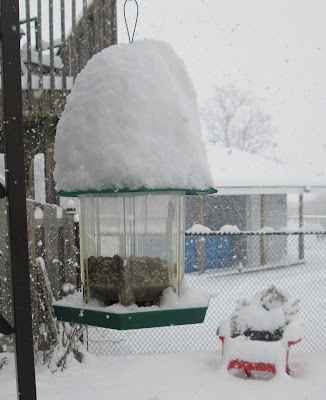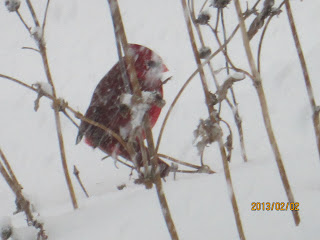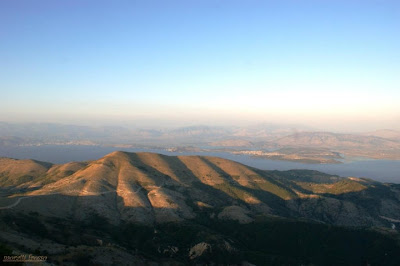Just over a year ago I was writing about winter in Corfu, and here I am doing the same thing again. Like
last year, the weather has suddenly turned really cold and my grandson Alexis
actually asked his mum to let him wear hat, scarf and gloves to go out –
unheard of from a small boy who usually displays blissful disdain for the cold.
It is often cold and windy here in Corfu
in winter, but I rarely feel the need to wear gloves. During the first few
winters that I lived here, I never even wore a coat – a warm jacket perhaps,
but not an actual coat. A friend contemplating a move to Corfu asked me then
about what clothes to bring and I told him to leave his sheepskin coat in the UK but
after a few days he was trying to get it shipped out. Maybe my blood has
thinned with the years of living in a climate that can give us temperatures
above 40 C, or perhaps advancing years have robbed me of that imperviousness to
the cold – anyway, my most recent purchase was a purple sheepskin coat!
Yes, my dears, purple. The favourite colour of older
ladies who wear it so well.
I don’t suppose the county set would approve of purple
sheepskin. It’s a bit, well hippyish,
you know. I dare not show it to my friend P… who has a wardrobe full of
designer clothes from the Sixties that she no longer has any occasion to wear (in
Corfu) but who trots out the Jean Muir
for Christmas and wears Ferragamo for gardening. I have never been a clothes
snob and in my old age feel free to break the fashion rules whenever I like.
There is something so regal about purple and yet so ever-so-slightly daring.
Suits me to a T.
Sixth January last year saw us driving north to the
great crescent beach of Avlaki, where the breakers rolled in before a strong
northerly wind and the snow on the mountains of Albania tried, and failed, to
glitter beneath a leaden sky.
Sixth January this year we contemplated a drive up to
the summit of Mount Pantocrator but though the sun was shining and the
atmosphere scoured of cloud or haze by gale force winds, there was something a
little intimidating about the prospect of standing on that exposed mountain top
with such a wind snatching at your clothing and forcing you to lean into it.
It’s quite a small summit, crowded with telecommunications masts and a
monastery, a peculiar juxtaposition. The sheer drop is sudden, steep, and it’s
a long, long way down.
We decided to drive south instead, and headed for the
other Corfiot mountain, Agii Deka (Ten Saints).
The road winds steadily upwards, flanked by rather
splendid homes and terrifying drops, but with spectacular views to take the
passenger’s mind off the vertigo-inducing sights and to keep the driver’s mind
firmly on his or her job. The village
of Agii Deka remains one
of those beautiful traditional villages, with a narrow street circumnavigating
the centre, a sheer but railed drop (of course) on one side and tantalisingly
photogenic houses piled one on top of the other on the other. You can only
appreciat5e such a place by walking, exploring the narrow alleys and the
apparently haphazardly placed buildings. Thank heaven for digital cameras – it
would have been all too easy to get through several rolls of film in the ‘old’
days.


The origins of Agii Deka, like those of so many
villages, certainly go back to Byzantine times and the tightly packed buildings
and narrow alleys derived from the need to foil the attacks of pirates through
the centuries. The origin of the name is obscure but may be connected to
Christian monks who escaped martyrdom in Albania
by fleeing to Corfu.
Somehow the past is never a closed chapter in Corfu – it is all around us, in place names, in traditions
and customs that are very much alive and not just a memory.
The drive from Agii Deka to the south is wonderful –
no-one who does it could continue to assert that Corfu
is over-developed and spoilt. I would recommend it to anyone who has been
watching the new British TV series about Kavos – the rowdy and unseemly
behaviour of its visitors is by no means typical of the south of Corfu which on
the whole remains so very traditional.
A vast expanse of apparently unbroken olive
groves undulates down to the sea, visible here on both the east and west
coasts. The resort of Benitses with its smart new marina, looks tiny from this
height. Hills of amazingly geometric shape sprout up completely devoid of even
a shed let alone an apartment block. Spiralling down towards Messonghi, via
Stavros, the road is lined with small clusters of houses, old-fashioned
cafeneions and small vineyards that benefit from the southerly aspect, and
there is a view of the sun-struck western sea, burnished to gold by the midday
sun – a Homeric view that dazzles the mind and the eye.
We coasted along empty roads to Messonghi and swung on
to the old road that runs by the sea to Boukari and Petreti.
Unknown to people who usually holiday in the north of
the island, this route is a revelation. A road that dips and bends alongside
the sea, lined with tamarisk, bamboo and olive trees, sheltering houses built
by local people in the days when land by the sea was considered worthless and
went for a song. Not an area of luxury villas on the whole, these are simple
homes with the inestimable asset of being right on the shore line. Here and
there are fish restaurants, popular with locals who come out from town on summer
Sundays, armed with their newspapers and supplements, to enjoy fresh fish in
the circumstances that endeared Greece to so many of us – a slightly wobbly
table under a thatched shade, close enough to the sea to be able to flick your
olive pits into it to annoy the tiny fish. The service is leisurely and the
cats under the table are patient but quietly persistent

Needless to say, at this time of the year the seaside
eateries are closed up, swathed in sheets of plastic against the sea that can
be - as it was on this day - rough and destructive.
Further along the coast road is Petreti, a small
harbour popular with yachtsmen and local sailors and home to a colourful group
of quite large fishing boats whose crews can be overheard chatting in Arabic,
Albanian and Turkish. It presented a very ‘closed-up’ look when we visited on
this January day. Restaurants shut, thatched sun shades battered and shredded by
the wind, a solitary black dog wandering disconsolately, thin, deprived of the
generosity of summer visitors. Even the fishing boats with their trawling
equipment were silent and still, the nets and floats piled tidily on the
quayside like a heap of onions.
We turned inland here and followed the main road
south. It runs like a spine down the centre of the island which is at its
narrowest here. To our right the sun gleamed upon the sea that once came right
up to the level of the road but now lies far away beyond sand dunes bordered by
long beaches of golden sand.
These magnificent beaches are for the most part very
quiet, even in the height of summer and are noteworthy for their surfing (board
or kite), for their solitude and the sunsets.

Kavos, subject of recent TV series is not the
sprawling blot on the landscape of Corfu that
you might imagine. It is tucked away on the southeast coast, its vulgarity confined behind the surrounding olive groves,
a lure to British youth on a hair-letting-down spree, but of little appeal to
older. More mature visitors. You can quite easily pass it by and drive into
Lefkimmi, which must be one of the most fascinating villages on Corfu. It was one of the last places in Corfu
to become familiar with the visits of tourists. Life remained feudal and
unchanged there for many years. On my first visit, back in the Seventies, I
drove along the ‘main’ street towards the river, in an open Triumph sports car,
with a girlftiend. All along the street, men were sitting in groups, outside
houses and cafeneions, smoking, chatting, clicking their worry-beads. We drove
slowly, aware of the frowns if disbeliefs. One man stared aggressively then
turned his head away and spat on to the uneven pavement – a classic Greek
gesture of disapproval. My Greek was adequate enough for me to understand his
comment: ‘Look at that! Women , on their own and driving a car!’
An unusual sight in Lefkimmi!
Lefkimmi is actually a conglomeration of several
villages, established in Paleolithis times though much of what we now see dates
back to Byzantine and Venetian times. There is nothing else in Corfu quite like the layout and architecture of this
village. It reminds me of the islands of the Venetian lagoon and, with the
river running through it, it is also very reminiscent of an old Dutch village.
Boats of all kinds tie up alongside the river banks
and in summer there is nothing more pleasant than a drink or a meal at one of
the riverside establishments. But we went in winter, and nothing was open. We
always take a flask of what you might call ‘fortified coffee’ on our jaunts – a
habit I learned from my parents and one my own family cheerfully continues to
indulge in – so we sat by the river in the sun and, not for the first time,
pondered on our good fortune in living in Corfu.
We did not have time on this short winter day to
explore any further, but there are endless possibilities – the white, hill-top
village of Chlomos, the cliffs of Arkoudillas at the southernmost tip of Corfu,
the octagonal and wondrous fortress of Gardiki, built in Byzantine times by the
same man who built the equally wondrous Angelokastro on the northwest coast.
Pic ark and gard and chlomos.
The view from Chlomos acress southern Corfu
Aerial view Gaediki Castle
Southernmost Corfu - Arkoudillas
Since I started to put this blog together, the weather
has changed and changed again. Today the weather is coming up from the south –
bringing strong wings and milder temperatures. A few days ago we had the ‘red
rain that comes on the back of the winds from the Libyan
desert. (The Italians call it ‘blood rain’). More recently, the
island shook every few minutes with earthquakes, one of which shook us all to
the accompaniment of a sound like thunder.
All part of the rich tapestry of weather, climate and
natural phenomena that make life on this island so interesting!
Sunset Vitalades














































